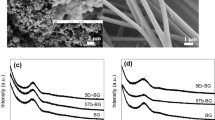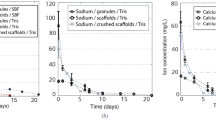Abstract
Microfibrous bioactive glasses are showing a considerable capacity to heal soft tissue wounds, but little information is available on the mechanism of healing. In the present study, the conversion of microfibrous borate bioactive glass (diameter = 0.2–5 μm) with the composition designated 13-93B3 (5.5 Na2O, 11.1 K2O, 4.6 MgO, 18.5 CaO, 3.7 P2O5, 56.6 B2O3 wt%) was evaluated in vitro as a function of immersion time in a simulated body fluid (SBF) at 37 °C using structural and chemical techniques. Silicate 45S5glass microfibers (45 SiO2, 24.5 Na2O, 24.5 CaO, 6 P2O5 wt%) were also studied for comparison. Microfibrous 13-93B3 glass degraded almost completely and converted to a calcium phosphate material within 7–14 days in SBF, whereas >85 % of the silica remained in the 45S5 microfibers, forming a silica gel phase. An amorphous calcium phosphate (ACP) product that formed on the 13-93B3 microfibers crystallized at a slower rate to hydroxyapatite (HA) when compared to the ACP that formed on the 45S5 fibers. For immersion times >3 days, the 13-93B3 fibers released a higher concentration of Ca into the SBF than the 45S5 fibers. The fast and more complete degradation, slow crystallization of the ACP product, and higher concentration of dissolved Ca in SBF could contribute to the capacity of the microfibrous borate 13-93B3 glass to heal soft tissue wounds.










Similar content being viewed by others
References
Rahaman MN, DE Day, Sonny BB, Fu Q, Jung SB, Bonewald LF, et al. Bioactive glass in tissue engineering. Acta Biomater. 2011;7:2355–73.
Hench LL. The story of Bioglass. J Mater Sci Mater Med. 2006;17:967–78.
Day DE, White JE, Brown RF, McMenamin KD. Transformation of borate glasses into biologically useful materials. Glass Technol. 2003;44:75–81.
Han X, Day DE. Reaction of sodium calcium borate glasses to form hydroxyapatite. J Mater Sci Mater Med. 2007;18:1837–47.
Day DE, Erbe EM, Richard M, Wojcik JA. Bioactive mater US Patent. 2004;6709:744.
Ahmed I, Lewis M, Olsen I, Knowles JC. Phosphate glasses for tissue engineering: part 1. Processing and characterisation of a ternary-based P2O5–CaO–Na2O glass system. Biomaterials. 2004;25:491–9.
Huang W, Day DE, Kittiratanapiboon K, Rahaman MN. Kinetics and mechanisms of the conversion of silicate (45S5), borate, and borosilicate glasses to hydroxyapatite in dilute phosphate solutions. J Mater Sci Mater Med. 2006;17:583–96.
Yao A, Wang D, Huang W, Fu Q, Rahaman MN, Day DE. In vitro bioactive characteristics of borate-based glasses with controllable degradation behavior. J Am Ceram Soc. 2007;90:303–6.
Fu Q, Rahaman MN, Fu H, Liu X. Silicate, borosilicate, and borate bioactive glass scaffolds with controllable degradation rate for bone tissue engineering applications. I. Preparation and in vitro degradation. J Biomed Mater Res A. 2010;95:164–71.
Wheeler DL, Stokes KE, Hoellrich RG, Chamberland DL, McLoughlin SW. Effect of bioactive glass particle size on osseous regeneration of cancellous defects. J Biomed Mater Res. 1998;41:527–33.
Xynos ID, Edgar AJ, Buttery LDK, Hench LL, Polak JM. Gene-expression profiling of human osteoblasts following treatment with the ionic products of Bioglass® 45S5 dissolution. J Biomed Mater Res. 2001;55:151–7.
Irion G. Comprehensive wound management. 2nd ed. Thorofare: SLACK Incoporated; 2010.
Lansdown ABG. Calcium: a potential central regulator in wound healing in the skin. Wound Repair Regen. 2002;10:271–85.
Barnett SE, Varley SJ. The effects of calcium alginate on wound healing. Ann Roy Coll Surg. 1987;69:153–5.
Gorustovich AA, Roether JA, Boccaccini AR. Effect of bioactive glasses on angiogenesis: a review of in vitro and in vivo evidences. Tissue Eng Pt B Rev. 2010;16:199–207.
Jung SB. Borate based bioactive glass scaffolds for hard and soft tissue engineering. PhD thesis, Missouri University of Science and Technology; 2010.
Quintero F, Pou J, Comesaña R, Lusquiños F, Riveiro A, Mann AB, et al. Laser spinning of bioactive glass nanofibers. Adv Funct Mater. 2009;19:3084–90.
Kim HW, Kim HE, Knowles JC. Production and potential of bioactive glass nanofibers as a next-generation biomaterial. Adv Funct Mater. 2006;16:1529–35.
Xia W, Zhang D, Chang J. Fabrication and in vitro biomineralization of bioactive glass (BG) nanofibres. Nanotechnology. 2007;18:135601.
Gao C, Gao Q, Bao X, Li Y, Teramoto A, Abe K. Preparation and in vitro bioactivity of novel mesoporous borosilicate bioactive glass nanofibers. J Am Ceram Soc. 2011;94:2841–5.
Jo J-H, Lee E-J, Shin D-S, Kim H-E, Kim H-W, Koh Y-H, et al. In vitro/in vivo biocompatibility and mechanical properties of bioactive glass nanofiber and poly(ε-caprolactone) composite materials. J Biomed Mater Res B. 2009;91B:213–20.
Wray P. ‘Cotton candy’ that heals? Borate glass nanofibers look promising. Am Ceram Soc Bull. 2011;90:25–9.
Kokubo T, Kushitani H, Sakka S, Kitsugi T, Yamamuro T. Solutions able to reproduce in vivo surface-structure changes in bioactive glass-ceramic A–W. J Biomed Mater Res. 1990;24:721–34.
Verhoef AH, den Hartog HW. Structure and dynamics of alkali borate glasses: a molecular dynamics study. J Non-Cryst Solids. 1995;182:235–47.
Kamitsos EI, Karakassides MA, Chryssikos GD. Vibrational spectra of magnesium-sodium-borate glasses. 2. Raman and mid-infrared investigation of the network structure. J Phys Chem. 1987;91:1073–9.
Kim CY, Clark AE, Hench LL. Early stages of calcium-phosphate layer formation in bioglasses. J Non-Cryst Solids. 1989;113:195–202.
Rehman I, Bonfield W. Characterization of hydroxyapatite and carbonated apatite by photo acoustic FTIR spectroscopy. J Mater Sci Mater Med. 1997;8:1–4.
Filgueiras MR, La Torre G, Hench LL. Solution effects on the surface reactions of a bioactive glass. J Biomed Mater Res. 1993;27:445–53.
Termine JD, Posner AS. Infra-red determination of the percentage of crystallinity in apatitic calcium phosphates. Nature. 1966;211:268–70.
Reiche I, Vignaud C, Menu M. The crystallinity of ancient bone and dentine: new insights by transmission electron microscopy. Archaeometry. 2002;44:447–59.
Mahamid J, Sharir A, Addadi L, Weiner S. Amorphous calcium phosphate is a major component of the forming fin bones of zebrafish: indications for an amorphous precursor phase. Proc Natl Acad Sci USA. 2008;105:12748–53.
Varshneya AK. Fundamentals of inorganic glasses. San Diego: Academic Press; 1994.
Pereira MM, Clark AE, Hench LL. Effect of texture on the rate of hydroxyapatite formation on gel-silica surface. J Am Ceram Soc. 1995;78:2463–8.
Hayakawa S, Tsuru K, Ohtsuki C, Osaka A. Mechanism of apatite formation on a sodium silicate glass in a simulated body fluid. J Am Ceram Soc. 1999;82:2155–60.
Eanes ED, Termine JD, Nylen MU. An electron microscopic study of the formation of amorphous calcium phosphate and its transformation to crystalline apatite. Calc Tissue Res. 1973;12:143–58.
Eanes ED, Gillessen IH, Posner AS. Intermediate states in the precipitation of hydroxyapatite. Nature. 1965;208:365–7.
Dorozhkin SV. Amorphous calcium (ortho)phosphates. Acta Biomater. 2010;6:4457–75.
Bilezikian JP, Raisz LG, Rodan GA. Principles of bone biology. San Diego: Academic Press; 2002.
Heinonen JK. Biological role of inorganic pyrophosphate. London: Kluwer Academic; 2001.
Bunker BC. Molecular mechanisms for corrosion of silica and silicate glasses. J Non-Cryst Solids. 1994;179:300–8.
Liu X, Huang W, Fu H, Yao A, Wang D, Pan H, et al. Bioactive borosilicate glass scaffolds: in vitro degradation and bioactivity behaviors. J Mater Sci Mater Med. 2009;20:1237–43.
Ohtsuki C, Kokubo T, Yamamuro T. Mechanism of apatite formation on CaO–SiO2–P2O5 glasses in a simulated body fluid. J Non-Cryst Solids. 1992;143:84–92.
Nelson DG. The influence of carbonate on the atomic structure and reactivity of hydroxyapatite. J Dent Res. 1981;60:1621–9.
LeGeros RZ. Calcium phosphates in oral biology and medicine. Monogr Oral Sci. 1991;15:1–201.
Fulmer MT, Ison IC, Hankermayer CR, Constantz BR, Ross J. Measurements of the solubilities and dissolution rates of several hydroxyapatites. Biomaterials. 2002;23:751–5.
Alexander GB, Heston WM, Iler RK. The solubility of amorphous silica in water. J Phys Chem. 1954;58:453–5.
Clark DE, Pantano CG Jr, Hench LL. Corrosion of glass. New York: Books for industry and the glass industry; 1979.
Acknowledgments
The authors thank Mo-Sci Corp. Rolla, Missouri, USA, for providing the microfibrous glass used in this work, Yetunde Oladapo for assistance with FTIR and XRD sample preparation, and Dr. Kai Song for assistance with TEM.
Author information
Authors and Affiliations
Corresponding author
Rights and permissions
About this article
Cite this article
Liu, X., Rahaman, M.N. & Day, D.E. Conversion of melt-derived microfibrous borate (13-93B3) and silicate (45S5) bioactive glass in a simulated body fluid. J Mater Sci: Mater Med 24, 583–595 (2013). https://doi.org/10.1007/s10856-012-4831-z
Received:
Accepted:
Published:
Issue Date:
DOI: https://doi.org/10.1007/s10856-012-4831-z




